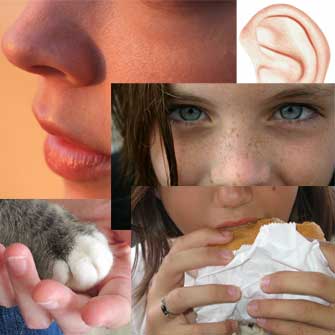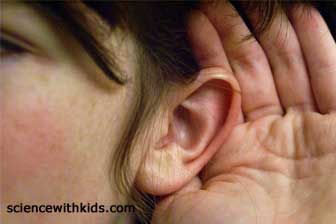Facts about the Five Senses
Posted by Admin / in Science Facts

Facts about the Senses
- The 5 main senses are touch, taste, sight, smell and hearing.
- The human brain is the organ that has the ability to use input from the senses to tell us what we smell, see, taste, hear our feel.
- Input from the senses are carried from special nerve cells called neurons to the brain.
- People can lose the ability of one or more senses and still survive. For example, some people who have lost or were not born with the sense of hearing have learned the ability to read lips or sign language to communicate directly with other people.
Facts about Smell
- People have approximately 10 million smell receptors in the cavity behind the nose.
- A majority of people know the difference between 4,000 to 10,000 different smells.
- As people age, their sense of smell declines.
- The sense of smell improves when you are hungry.
Facts about the Sight

- Similar to a digital camera, but much more sophisticated, our eyes are able to convert light into signals. Our bodies use nerve impulses instead of electrical impulses.
- The eye has many parts we can see and some we cannot see.
- The pupil is the dark spot in the center of the eye we can see. It allows light to enter the eye. When it is bright the pupil gets smaller so too much light does not enter the eye. When it is dark the pupil gets larger to allow more light to enter.
- The iris is the colored part of the eye we can see. People have different color eyes including brown, dark, blue, green, hazel and other mixtures of colors. The iris is actually a muscle that changes the size of the pupil when needed.
- The cornea is the clear protective coating on the eye.
- The white part of the eye is called the sclera.
- Light enters the eye through the pupil and then passes through a clear flexible tissue called the lens.
- The back of the eye is called the retina. After light passes through the lens the light hits the retina. The retina then converts the light into nerve impulses.
- Nerve impulses from the retina are transferred to the brain through the optic nerve.
- The eye has six muscles that help it to move.
- Having two eyes helps us judge depth.
- Eyelids help protect and clean the eye. On average people blink about 10 times per minute when they are fully awake.
- People require corrective eye glasses or contact lenses because the eyeball has the wrong shape. Over time changes in the shape of the eyeball can lead to near-sightedness or far-sightedness. Corrective lenses can help people see well again.
Facts about the Touch
- The largest organ in the body is skin. Skin is also responsible for a majority of the sense of touch.
- The skin has difference receptors that can feel pressure, moisture, temperature, vibration and pain.
- Most touch sensors send data right to the brain.
- There are certain touch sensors that do not send data directly to the brain. These touch sensors are called reflexes. Reflexes send data right to muscles to help protect the body. After the muscles respond, the data is then sent to the brain.
- We feel pain to help protect our body. In fact, pain can be one of the strongest memories we have. Experiencing pain also helps us to learn not to repeat activities that may damage our body.
Facts about the Taste

- The tongue has the taste sensors that provide information to the brain.
- People have approximately 8000 taste buds on their tongue.
- Taste buds are located on each side of tiny bumps on the tongue called papillae.
- Children have more taste buds than adults.
- There are four types of taste buds which can taste different things. The four types include sweet, salty, sour and bitter. This is why flavors that react with more than one type of taste bud are interesting.
- The different types of tast buds are located on different areas of the tongue. Sweet taste buds are located at the front. Sour taste buds are one the sides of the tongue. Salty taste buds are located at the front and sides of the tongue. Bitter taste buds are located at the back of the tongue.
- To distinguish taste, the brain uses about 20 percent of the data from the tongues taste buds and about 80 percent from smell receptors.
- Foods like onions, garlic, spicy foods and hot (temperature) foods can dull the sense of taste. Alcohol, smoking and caffeine also have the same effect.
Facts about Hearing

- Our ears provide our sense of hearing.
- The ear contains 3 main areas including the outer ear, middle ear and inner ear.
- Sound waves from the air enter the outer ear. The outer ear is like a funnel that helps direct sounds to the ear canal in the middle ear.
- The ear drum inside the middle ear converts sound waves to vibrations.
- The middle ear also contains the three smallest bones in the human body. These bones transfer the vibrations to the inner ear.
- The inner ear is where vibrations from the middle ear are converted to electrical impulses that are then transferred to the brain.
